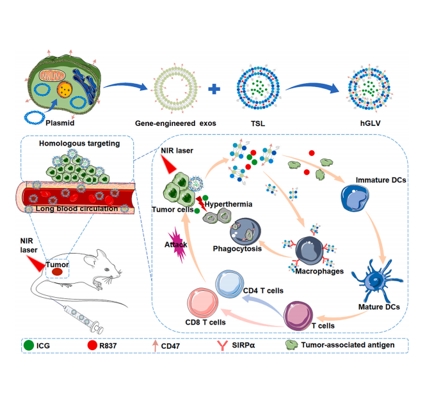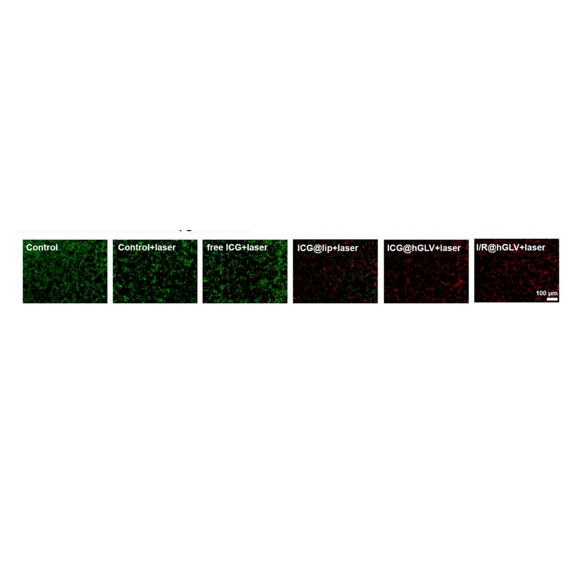文献:
Gene-engineered exosomes-thermosensitive liposomes hybrid nanovesicles by the blockade of CD47 signal for combined photothermal therapy and cancer immunotherapy
文献链接:
https://www.sciencedirect.com/science/article/abs/pii/S0142961221003203作者:
Lili Cheng , Xiaoge Zhang , Junjie Tang , Qijun Lv , Jie Liu
相关产品:
1,2-distearoyl-sn-glycero-3-phosphoethanolamine-N-[methoxy (polyethylene glycol)-2000]
二硬脂酰基磷脂酰乙醇胺-聚乙二醇2000
原文摘要:
CD47, overexpressed on kinds of tumor cells, activates a “don’t eat me” signal through binding to signal regulatory protein α (SIRPα), leading to immune escape from the mononuclear phagocyte system (MPS). It is also a huge challenge to deliver therapeutic drugs to the tumor sites due to the short retention time in blood, poor targeting of tumor cells and accelerated clearance by MPS. Herein, we designed a hybrid therapeutic nanovesicles, named as hGLV, by fusing gene-engineered exosomes with drug-loaded thermosensitive liposomes. We demonstrated that the CD47-overexpressed hGLV exhibited the long blood circulation and improved the macrophages-mediated the phagocytosis of tumor cells by blocking CD47 signal. Moreover, the resulted hGLV could remarkably target the homologous tumor in mice, achieving the preferential accumulation at the tumor sites. Importantly, hGLV loading the photothermal agent could achieve the excellent photothermal therapy (PTT) under laser irradiation after the intravenous injection, completely eliminating the tumors, leading to immunogenic cell death and generating substantial tumor-associated antigens, which could promote the maturation of immature dendritic cells with the help of the co-encapsulated immune adjuvant to trigger strong immune responses. Generally, the hybrid nanovesicles based on CD47 immune check point blockade can be a promising platform for the drug delivery in cancer treatment.
DSPE-PEG2000,也被称为二硬脂酰基磷脂酰乙醇胺-聚乙二醇2000,是一种基于脂质的分子,由两个主要组分组成:一种叫做二硬脂酸-sn-甘油-3-磷酸乙醇胺(DSPE)的磷脂和一个平均分子量为2000的聚乙二醇(PEG)链。DSPE组分提供了脂质特性,使DSPE-PEG2000具有疏水性。PEG组分则赋予分子亲水性,使得DSPE-PEG2000整体具有亲水性和疏水性的平衡。DSPE-PEG2000具有良好的生物相容性和可降解性。该文献基于DSPE-PEG2000良好的性质制备了ICG负载或r837负载的热敏脂质体TSL。

图:设计原理及作用机制
DSPE-PEG2000在ICG负载或r837负载的热敏脂质体的制备:
首先制备热敏脂质体TSL:将DPPC、DSPE-PEG2000、MSPC与氯仿以一定的摩尔比混合。将混合物摇晃均匀,以完全溶解。然后,溶剂通过旋转蒸发器蒸发,形成脂质膜。脂质膜用 PBS水合一段时间。然后,用超声处理溶液,然后通过聚碳酸酯膜挤压几次。然后为了制备装载ICG/R837的热敏脂质体(I/R@lip),将R837加入到脂质溶液中,在水化过程中用ICG溶液取代PBS。其他程序与上述方法相同。最后,ICG和R837在一定温度下过夜去除未封装的ICG。同时,还分别制备了ICG负载或r837负载的热敏脂质体(ICG@lip或R837@lip)。
为了评估外泌体与脂质体的融合效率,脂质体用DSPE-PEG2000-FITC标记,外泌体用cd9免疫磁珠标记。然后,在分离免疫磁珠的磁场中筛选出杂交纳米囊泡和未融合的外泌体,然后用Flow Nano Analyzer测量表征杂交纳米囊泡的FITC在中的荧光强度和杂交纳米囊泡的颗粒浓度。

图:荧光标记图像
结论:
DSPE-PEG2000成功制备了热敏脂质体,通过荧光染料标记得到的ICG负载或r837负载的热敏脂质体,该脂质体具有具有良好的光敏性和生物相容性。在ICG@lip中,ICG的荧光性质使得该系统在体内外均可进行荧光追踪,便于监测分布和效果。脂质体结构稳定,能够保护ICG免受外界环境的破坏,同时确保其在体内的稳定释放。

 2024-12-18 作者:ws 来源:
2024-12-18 作者:ws 来源:

